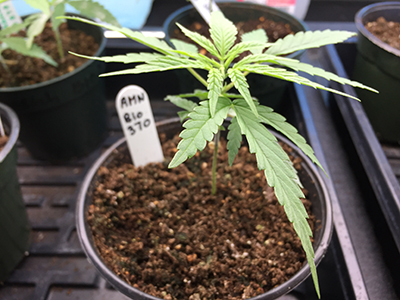What’s the best way to identify
male hemp seedlings?
The surge in cannabidiol popularity means more farmers are growing non-intoxicating strains of cannabis, or hemp, for CBD production. This new market has led to commercial genetic tests for early determination of hemp plant sex. However, a new study has found that these tests may not all produce accurate results.

pairs at determining the sex of hemp seedlings. Shown is an immature
industrial hemp plant.
CBD is used as an alternative treatment for pain and anxiety and various medical conditions. Unfertilized female cannabis plants produce high amounts of the CBD precursor in their flowers, making it important to identify and eliminate male plants at the seedling stage.
“The results from our undergraduate-led project can help hemp growers make accurate sex determination of seedlings,” said Allison Nalesnik, senior undergraduate student at Salisbury University. “This could help increase the yield of CBD, which should reduce prices for the public.”
Nalesnik was scheduled to present this research at the American Society for Biochemistry and Molecular Biology annual meeting in April in San Diego. Though the meeting, to be held in conjunction with the 2020 Experimental Biology conference, was canceled in response to the COVID-19 outbreak, the research team's abstract was published in The FASEB Journal.
Commercially available genetic tests use DNA markers known as primer pairs to identify male plants weeks before this could be determined visually. This helps farmers avoid spending time and money on growing plants that don’t produce flowers and that could potentially lower CBD production by fertilizing female plants.
The new study was conducted through a molecular genetics course offered at Salisbury University. Over the course of a semester, students in the course followed identical protocols to determine the sex of 13 hemp plants. They collectively assessed the effectiveness of three commercially available primer pairs using modern genetics equipment and techniques.
“Two of the primer pairs — SCAR119 and MADC2 — were effective for determining the sex of cannabis seedlings,” said Nalesnik. “The ineffective primer set would need to be tested further to more confidently say whether or not it is actually scientifically useful.”
Next steps for this research include investigating DNA markers that are only found on the male chromosome to see if these offer a more efficient way to determine the sex of hemp seedlings.
Enjoy reading ASBMB Today?
Become a member to receive the print edition four times a year and the digital edition monthly.
Learn moreGet the latest from ASBMB Today
Enter your email address, and we’ll send you a weekly email with recent articles, interviews and more.
Latest in Science
Science highlights or most popular articles

The science of staying strong
Muscles power every movement, but they also tell the story of aging itself. Scientists are uncovering how strength fades, why some species resist it and what lifestyle and molecular clues could help preserve muscle health for life.

Bacteriophage protein could make queso fresco safer
Researchers characterized the structure and function of PlyP100, a bacteriophage protein that shows promise as a food-safe antimicrobial for preventing Listeria monocytogenes growth in fresh cheeses.

Building the blueprint to block HIV
Wesley Sundquist will present his work on the HIV capsid and revolutionary drug, Lenacapavir, at the ASBMB Annual Meeting, March 7–10, in Maryland.

Gut microbes hijack cancer pathway in high-fat diets
Researchers at the Feinstein Institutes for Medical Research found that a high-fat diet increases ammonia-producing bacteria in the gut microbiome of mice, which in turn disrupts TGF-β signaling and promotes colorectal cancer.

Mapping fentanyl’s cellular footprint
Using a new imaging method, researchers at State University of New York at Buffalo traced fentanyl’s effects inside brain immune cells, revealing how the drug alters lipid droplets, pointing to new paths for addiction diagnostics.

Designing life’s building blocks with AI
Tanja Kortemme, a professor at the University of California, San Francisco, will discuss her research using computational biology to engineer proteins at the 2026 ASBMB Annual Meeting.

